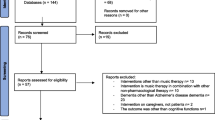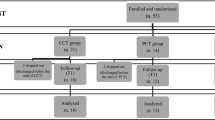Abstract
Background
The well known global improvement of quality of life (QoL) after bilateral high frequency chronic deep brain stimulation of the subthalamic nucleus (STN DBS) in Parkinson’s disease (PD) is in contrast to behavioral disturbances as observed after surgery. Indeed the impact of DBS on physical versus mental aspects of QoL in PD remains unknown.
Objective
To assess the influence of bilateral STN DBS on physical versus mental aspects of QoL in Parkinson’s disease.
Methods
The results of 27 patients for the Unified Parkinson’s disease Rating Scale (UPDRS), Parkinson’s Disease Questionnaire 39 (PDQ39) and Short Form 36 health survey questionnaire (SF36) were compared before surgery and after 12 months of bilateral STN DBS.
Results
Comparing off–dopa conditions before versus 12 months after surgery, both UPDRS part II and part III significantly improved: 32.6% and 52%, respectively. UPDRS part I scores did not change significantly at 12 months. As for PDQ39, the global score significantly improved after surgery (21.1 %) as did four subscores: mobility (25.6 %), activity of daily living (34.5 %), stigma (40.1 %) and bodily discomfort (30 %). Three PDQ39 subscores, however, showed no significant changes: emotional well–being (10.7 %), social support (3.2%) and cognition (8.5 %) and one item even worsened: communication (–7.7 %). In SF36, only physical items significantly improved.
Conclusion
Using clinician’s based rating scale, bilateral STN DBS showed significant improvement in PD patients at 12 month follow up. However, using patient’s self–assessment scales, the clinical benefit of STN DBS was more subtle: physical items of QoL significantly improved, whereas mental items such as emotional well–being, social support, cognition and communication showed no improvement. Our results are suggestive of a dissociation of motor and non–motor symptoms control after bilateral STN DBS in PD patients.
Similar content being viewed by others
References
Berney A, Vingerhoets F, Perrin A, Guex P, Villemure JG, Burkhard PR, Benkelfat C, Ghika J (2002) Effect on mood of subthalamic DBS for Parkinson’s disease: a consecutive series of 24 patients. Neurology 59:1427–1429
CAPIT Committee: Langston JW, Widner H,Goetz CG, Brooks D, Fahn S, Freeman T,Watts R (1992) Core Assessment Program for Intracerebral Transplantations. Mov Disord 7:2–13
Damiano AM, Snyder C, Strausser B, Willian MK (1999) A review of healthrelated quality of life concepts and measures for Parkinson’s disease. Qual Life Res 8(3):235–243
Fahn S, Elton RL,members of UPDRS development committee (1987) Unified Parkinson Disease Rating Scale. In: Fahn S,Marsden CD, Calne DB (eds) Recent Developments in Parkinson’s disease. Florham Park, NJ: Macmillan Health Care Information, pp 153–164
Gibb WRG, Lees AJ (1988) The relevance of the Lewy body to the pathogenesis of idiopathic Parkinson’s disease. J Neurol Neurosurg Psychiatry 51:745–752
Houeto JL, Damier P, Bejjani PB, Staedler C, Bonnet AM, Arnulf I, Pidoux B, Dormont D, Cornu P, Agid Y (2000) Subthalamic stimulation in Parkinson’s disease. A multidisciplinary approach. Arch Neurol 57:461–465
Just H, Ostergaard K (2002) Healthrelated quality of life in patients with advanced Parkinson’s disease treated with deep brain stimulation of the subthalamic nuclei. Mov Disord 17(3):539–545
Kumar R, Lozano AM, Kim YJ, Hutchison WD, Sime E, Halket E, Lang AE (1998) Double-blind evaluation of subthalamic nucleus deep brain stimulation in advanced Parkinson’s disease. Neurology 51:850–855
Kuopio AM, Marttila RJ, Helenius H, Toivonen M, Rinne UK (2000) The quality of life in Parkinson’s disease. Mov Disord 15:216–223
Lagrange E, Krack P, Moro E, Ardouin C, Van Blercom N, Chabardes S, Benabid AL, Pollak P (2002) Bilateral subthalamic nucleus stimulation improves health-related quality of life in PD. Neurology 59:1976–1978
Lezcano E, Gomez-Esteban JC, Zarranz JJ, Lambarri I, Madoz P, Bilbao G, Pomposo I, Garibi J (2004) Improvement in quality of life in patients with advanced Parkinson’s disease following bilateral deep-brain stimulation in subthalamic nucleus. Eur J Neurol 141(7):451–454
Limousin P, Krack P, Pollak P, Benazzouz A, Ardouin C, Hoffmann D, Benabid AL (1998) Electrical stimulation of the subthalamic nucleus in advanced Parkinson’s disease. N Engl J Med 339:1105–1111
Limousin P, Pollak P, Benazzouz A (1995) Effect on parkinsonian signs and symptoms of bilateral subthalamic nucleus stimulation. Lancet 345:91–95
Lozano AM, Lang AE, Galvez-Jimenez N, Miyasaki J, Duff J, Hutchinson WD, Drostovsky JO (1995) Effect of GPi pallidotomy on motor function in Parkinson’s disease. Lancet 25: 1383–1397
Martínez-Martín P (1998) An introduction to the concept of quality of life in Parkinson’s disease. J Neurol 245 (Suppl 1):2–5
Martínez-Martín P,Valldeoriola F, Tolosa E, Pilleri M, Molinuevo JL, Rumià J, Ferrer E (2002) Bilateral subthalamic nucleus stimulation and quality of life in advanced Parkinson’s disease. Mov Disord 17(2):372–377
Mattis S (1988) Dementia rating scale. Resources Inc.Odessa, FL: Psychological Assessment
Montgomery SA, Asberg M (1979) A new depression scale designed to be sensitive to change. Br J Psychiatry 134:382–389
Moro E, Scerrati M, Romito LMA, Roselli R, Tonali P, Albanese A (1999) Chronic subthalamic nucleus stimulation reduces medication requirements in Parkinson’s disease. Neurology 53:85–90
Patel NK, Plaha P, O’Sullivan K, Mc-Carter R, Heywood P, Gill SS (2003) MRI directed bilateral stimulation of the subthalamic nucleus in patients with Parkinson’s disease. J Neurol Neurosurg Psychiatry 74:1631–1637
Peto V, Fitzpatrick R, Jenkinson C (1997) Self-reported health status and access to health services in a community sample with Parkinson’s disease. Disabil Rehab 19:97–103
Peto V, Jenkinson C, Fitzpatrick R, Greenhall R (1995) The development and validation of a short measure of functioning and well being for individuals with Parkinson’s disease. Qual Life Res 4:241–248
Rubenstein LM, Voelker MD, Chrischilles EA, Glenn DC, Wallace RB, Rodnitzky RL (1998) The usefulness of the functional status questionnaire and medical outcomes study short form in Parkinson’s disease research. Qual Life Res 7:279–290
Saint-Cyr JA, Trépanier LL, Lumar R, Lozano AM, Lang E (2000) Neuropsychological consequences of chronic bilateral stimulation of the subthalamic nucleus in Parkinson’s disease. Brain 123:2091–2108
Schrag A, Hovris A, Morley D, Quinn N, Jahanshahi M (2003) Young-versus older-onset Parkinson’s disease: impact of disease and psychosocial consequences. Mov Disord 18(11): 1250–1256
Talairach J, David M, Tournoux P, Corredor H, Kvasina T (1957) Atlas d’anatomie stéréotaxique des noyaux gris centraux. Masson, Paris
Tröster AI, Fields JA, Wilkinson S, Pahwa R, Koller WC, Lyons KE (2003) Effect of motor improvement on quality of life following subthalamic stimulation is mediated by changes in depressive symptomatology. Stereotact Funct Neurosurg 80(1–4):43–47
Tröster AI, Lyons KE, Straits-Tröster K (1999) Determinants of health related quality of life changes in Parkinson’s disease. In:Martínez-Martín P, Koller WC (eds) Quality of life in Parkinson’s disease. Barcelona: ALEU, SA, pp 55–77
Ware JE, Kosinski M, Keller SD (1995) SF36 physical and mental health summary scales: a user manual. Boston, Massachusetts: Health Institute, New England Medical Center
Ware JE (1987) Standards for validating health measures: definition and content. J Chronic Dis 40:473–480
Ware JE (1996) The SF36 Health Survey. Quality of life and Pharmacoeconomics in Clinical Trials, Second Edition. Lippincott-Raven Publishers Philadelphia 34:337–345
Author information
Authors and Affiliations
Corresponding author
Rights and permissions
About this article
Cite this article
Drapier, S., Raoul, S., Drapier, D. et al. Only physical aspects of quality of life are significantly improved by bilateral subthalamic stimulation in Parkinson’s disease. J Neurol 252, 583–588 (2005). https://doi.org/10.1007/s00415-005-0704-4
Received:
Revised:
Accepted:
Published:
Issue Date:
DOI: https://doi.org/10.1007/s00415-005-0704-4




